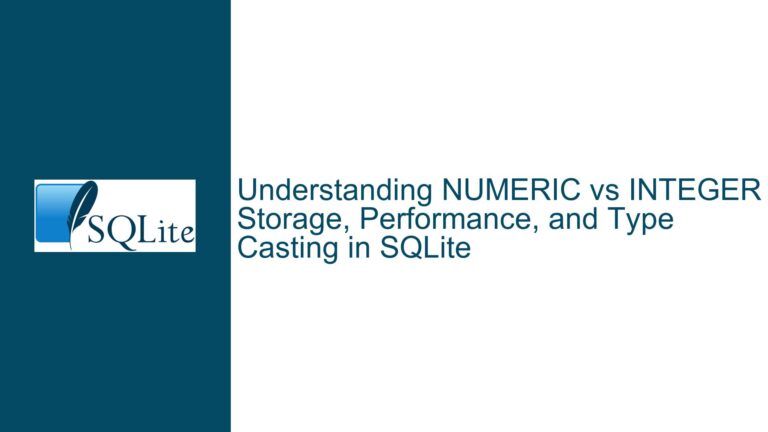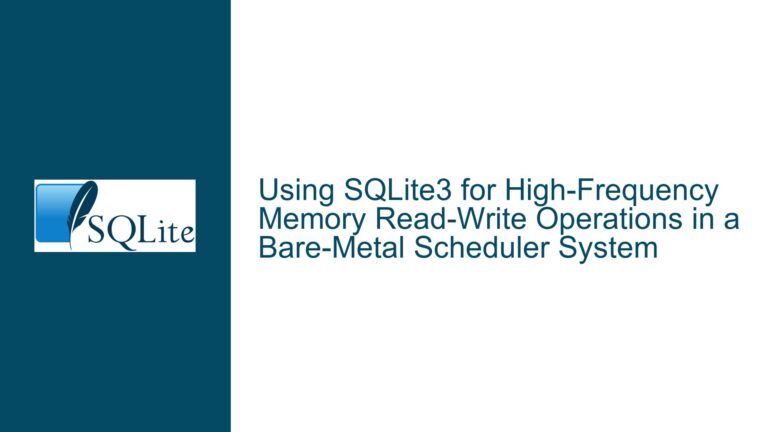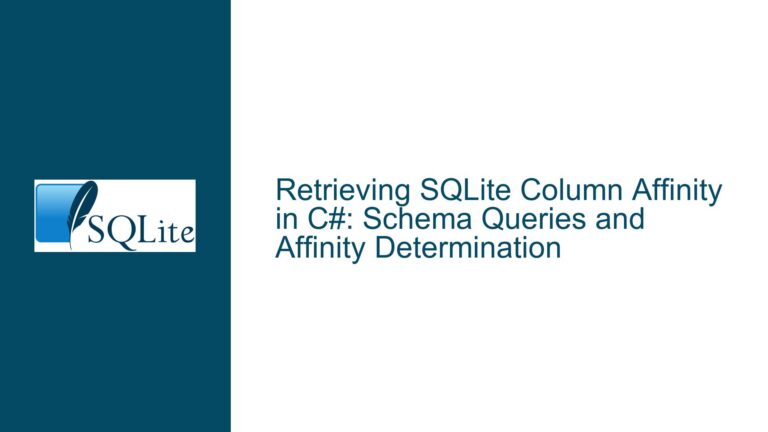Error: Database Disk Image Malformed When Deleting from sqlite_master
Understanding the "Database Disk Image Malformed" Error During Schema Manipulation
Issue Context: Direct Deletion from sqlite_master After SQLite 3.37.2 Upgrade
The error database disk image is malformed (11) occurs when attempting to delete all rows from the sqlite_master system table using a direct DELETE FROM sqlite_master; command in SQLite versions 3.37.2 and newer. This error arises specifically when the PRAGMA writable_schema=1; directive is enabled to allow schema modifications. Prior to version 3.37.2, this sequence worked without error, even though it was never officially supported.
The core problem stems from SQLite’s internal page reference counting mechanism. When deleting all rows from sqlite_master without a WHERE clause, SQLite attempts to clear the entire table in a single operation. In newer versions, this triggers a check in the clearDatabasePage() function to verify that the page reference count (sqlite3PagerPageRefcount) equals 1. If the count is higher (e.g., 2), the operation aborts with SQLITE_CORRUPT_BKPT, leading to the malformed database error.
This behavior change reflects SQLite’s stricter enforcement of internal consistency checks. The sqlite_master table (stored in page 1 of the database file) is critical for database integrity. When a transaction is active, page 1’s reference count increments to 2. The new check in clearDatabasePage() interprets this as a sign of corruption, even if the actual schema is logically valid.
Root Causes: Why Page Reference Counts and Schema Manipulation Collide
Unsupported Direct Schema Modifications
Thesqlite_mastertable is part of SQLite’s internal schema representation. Directly modifying it viaDELETEorINSERTcommands bypasses SQLite’s high-level schema management APIs (e.g.,CREATE TABLE,DROP TABLE). While thePRAGMA writable_schema=1;setting allows such modifications, it is explicitly documented as unsafe. The warning “misuse of this pragma can easily result in a corrupt database file” underscores that these operations are not guaranteed to work across versions.Transaction Locking and Page Reference Counts
When a transaction is active, SQLite increments the reference count of pages involved in the transaction. Page 1 (sqlite_master) is often pinned by ongoing transactions to ensure schema stability. In SQLite 3.37.2, theclearDatabasePage()function was modified to validate that the reference count of a page being cleared is exactly 1. If a transaction holds an additional reference (e.g., during aVACUUMoperation), this check fails, triggering the error.Optimizer-Dependent Query Execution Plans
The workaroundDELETE FROM sqlite_master WHERE 1;avoids the error by forcing SQLite to process each row individually instead of using the bulkClearoperation. This difference in execution plans bypasses the reference count check. However, reliance on this behavior is fragile: future query optimizations could eliminate theWHERE 1clause, reintroducing the error.
Resolving the Error: Safe Schema Reset and Mitigation Strategies
Step 1: Replace Direct Deletion with Supported Schema Operations
The only reliable way to reset a database schema is to use SQLite’s Data Definition Language (DDL) commands:
- Iterate Through User Tables: Use
SELECT name FROM sqlite_master WHERE type='table';to retrieve all user-defined tables. - Drop Tables Individually: Execute
DROP TABLEfor each table. System tables (e.g.,sqlite_sequence) should not be modified. - Reinitialize the Database: For a completely empty database, close all connections and delete/recreate the file.
Example Code:
PRAGMA writable_schema = 0; -- Ensure safety
BEGIN;
SELECT 'DROP TABLE ' || name FROM sqlite_master WHERE type='table';
-- Execute generated DROP TABLE statements
COMMIT;
VACUUM;
Step 2: Understand the Role of PRAGMA writable_schema
The writable_schema pragma exists for low-level recovery tools, not application-level operations. If you must use it:
- Always backup the database first.
- Avoid combining it with transactions.
- Prefer single-row operations (e.g.,
UPDATE sqlite_master SET sql='...' WHERE name='table_name';) over bulk deletions.
Step 3: Address the Reference Count Check in SQLite 3.37.2+
If you must delete all rows from sqlite_master, use the workaround DELETE FROM sqlite_master WHERE 1; to force row-by-row deletion. However, recognize that this is unsupported and may break in future versions.
Step 4: Monitor SQLite Codebase Changes
The SQLite team addressed this specific issue in commit a5ec16907ef6ab50, which relaxes the reference count check for page 1. To benefit from this fix:
- Upgrade to SQLite versions containing the commit.
- Rebuild the library from source if necessary.
Step 5: Adopt Transaction Isolation Best Practices
Ensure that no other transactions are holding references to page 1 when modifying the schema:
- Use
PRAGMA locking_mode=EXCLUSIVE;to prevent concurrent access. - Avoid long-running transactions during schema changes.
Final Recommendation: Avoid Direct Schema Manipulation
Use SQLite’s official APIs for schema changes. For programmatic schema resets, create a new database file and copy essential data. This approach is safer than attempting to purge and reconstruct the schema in-place.
This guide emphasizes that while workarounds exist, they are inherently unstable. The error database disk image is malformed serves as a reminder to adhere to supported practices, especially when interacting with SQLite’s internal structures.






